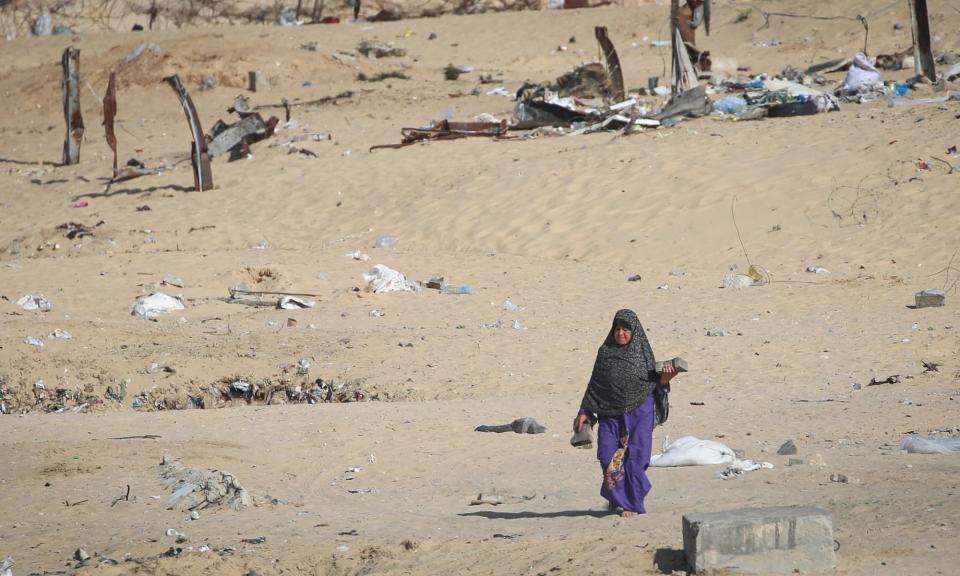UN says it has no more food or tents for nearly 2m people in Gaza

The UN has run out of tents and food to distribute to almost 2 million people in Gaza, the majority displaced from their homes and dependent on aid to stave off looming famine.
UN officials told the Guardian on Wednesday afternoon that their warehouses were now completely empty south of the river dividing the northern third of the Gaza from the south, with no likelihood of resupply as long as the main entry points into the territory remain closed after Israeli offensives launched in recent days.
“There are no tents in humanitarian warehouses. There are also no stocks of food left with World Food Programme or Unrwa [the UN agency for Palestinian refugees] south of the [river]. What people have had distributed to them, or what remains on the market, is all that’s left, and we expect that that will be finished soon,” said Georgios Petropoulos, head of the Gaza sub-office of UN office for the coordination of humanitarian affairs. “Time is running out to get a sustainable crossing open for predictable humanitarian supplies into southern Gaza.”
Throughout the seven-month conflict, the WFP and Unrwa have supplied much of Gaza’s population with basic essentials to survive. However, their distribution has depended on a flow of trucks principally through Gaza’s crossing with Egypt at Rafah and the nearby entry point from Israel, at Kerem Shalom.
The Rafah crossing remains shut after being seized by Israeli troops last week. Continued fighting and other acute logistical problems linked to the Israeli offensive on Rafah has made it impossible to bring in large numbers of convoys through Kerem Shalom, UN officials said.
Related: ‘No water, food, health care, toilet’: Desperation deepens in Gaza’s camps
Hundreds of thousands in Gaza have been forced to flee homes or temporary shelters by recent fighting.
More than 600,000 people have fled Rafah, according to the latest UN estimates, complying with instructions issued by Israeli military, which launched a long-threatened invasion of the city last week.
Another 100,000 people in the north have followed similar Israeli instructions to evacuate their homes or shelters before a new round of intense clashes between Israeli troops and Hamas.
All were told to move to a designated “expanded humanitarian zone” along Gaza’s southern coast where almost no provision has been made for shelter or food distribution. Medicals and aid officials describe “horrific and dehumanising conditions” in the zone, with acute shortages of shelter, water, food and sanitation.
Aid officials said 54 trucks had entered Gaza via the northern Erez crossing on Tuesday, and their cargos would allow some distribution in northern Gaza. But it is estimated that about 500 truckloads are needed to supply the essential needs of Gaza’s 2.3m population.
Though the few remaining hospitals and clinics in the territory have about a month’s stocks of medicines and basic supplies, an acute shortage of fuel has reduced services.
Israel has said it is ready to allow unlimited humanitarian supplies into Gaza and blames UN relief agencies and other international bodies for failing to distribute the aid properly.
The war began when Hamas attacked southern Israel on 7 October, killing about 1,200 people, mostly civilians, and taking another 250 hostage. They still hold about 100 captives and the remains of more than 30, and internationally mediated talks over a ceasefire and hostage release appear to be at a standstill.
The Israeli offensive has brought massive destruction, the displacement of about 2 million people and the deaths of about 35,000, mostly women and children, according to local Palestinian health officials.
In some of his strongest statements to date, the US secretary of state, Antony Blinken, said on Wednesday that Israel needed a clear and concrete plan for the future of Gaza where it faces the potential for a power vacuum that could become filled by chaos.
“We do not support and will not support an Israeli occupation. We also, of course, do not support Hamas governance in Gaza … We’ve seen where that’s led all too many times for the people of Gaza and for Israel. And we also can’t have anarchy and a vacuum that’s likely to be filled by chaos,” Blinken said during a press conference in Kyiv.
Israel was plunged into a new and bitter dispute with the UN after the Israeli army released drone footage showing unidentified armed men standing next to UN-marked vehicles at an Unrwa compound in Rafah.
Unrwa has been the target of fierce criticism by Israel, which accuses the agency of cooperating with Hamas in Gaza and has called for it to be disbanded. The agency strongly denies the accusations. A spokesperson said the agency was examining the footage.
There have been weekly protests by Israeli settlers and rightwing activists outside the headquarters of Unrwa in East Jerusalem, calling for its closure, with two apparent attempts to set the complex alight, the most recent on Monday.
Unrwa’s commissioner general, Philippe Lazzarini, said in a social media post on Tuesday that the attacks “have got to stop”.

 Yahoo Sport
Yahoo Sport 






































